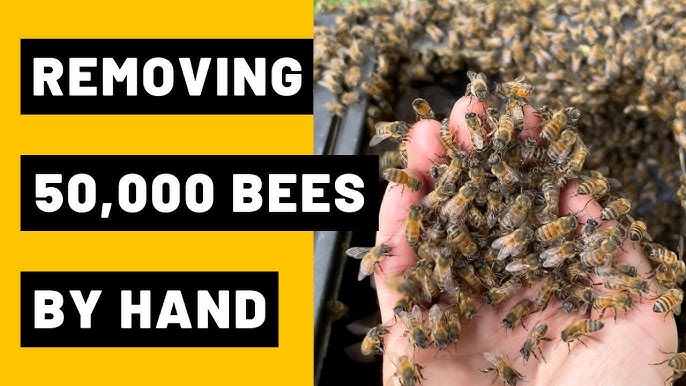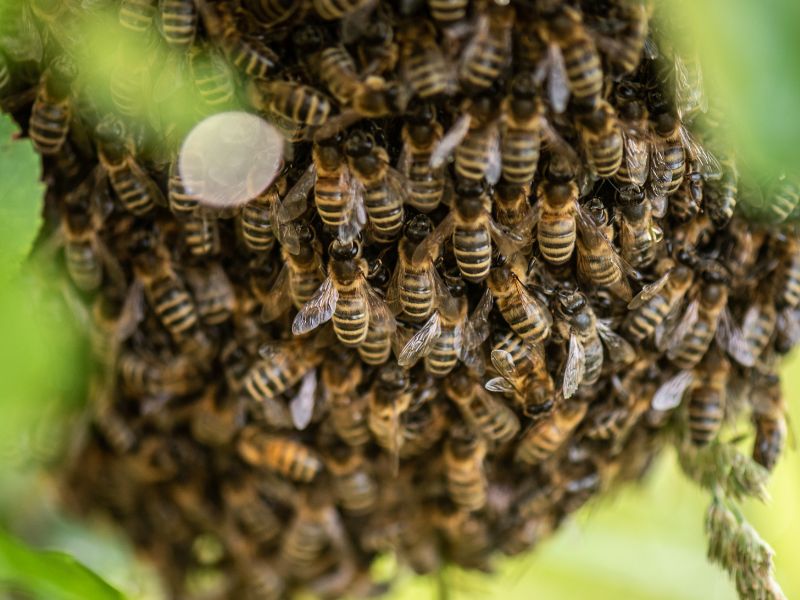To get rid of bees in your compost bin, remove sweet or fragrant materials that attract them. Cover the compost with a breathable tarp to deter bees.
Bees play a crucial role in pollination, but their presence in your compost bin can be a nuisance. They are often attracted to decomposing fruits and sugary substances, which can lead to unwanted encounters. Maintaining a balanced compost mix is vital.

Credit: www.reddit.com
Adding carbon-rich materials, like dried leaves or straw, helps reduce odors that lure bees. Keeping the compost moist but not soggy also minimizes the attraction. If bees persist, consider relocating the compost bin to a less frequented area. Taking these steps ensures a more pleasant composting experience while still supporting local bee populations.
How to Get Rid of Bees in Compost Bin : Step by Step Guide
The Buzz About Bees In Compost Bins
Bees are often drawn to compost bins for several reasons. They seek food sources like fruits and vegetables. Compost bins provide an ideal environment for them to thrive. The sweet smell of decomposing organic matter attracts them. Warmth from compost also creates a cozy habitat.
Understanding bees’ role in the ecosystem is vital. They are important for pollination, which helps plants grow. Bees also contribute to biodiversity, supporting various animal species. Removing them from compost bins should be done carefully, considering their benefits.
Some methods to deter bees include keeping the bin covered and using strong scents like vinegar. Maintaining a balanced compost mix can also help. Avoid adding overly sweet items to the bin.

Credit: m.youtube.com
Identifying The Bees In Your Compost
Bees, wasps, and hornets are often confused. Each has unique features that help in identification.
| Type | Appearance | Behavior |
|---|---|---|
| Bees | Fuzzy bodies, often black and yellow | Generally non-aggressive, focus on pollination |
| Wasps | Smooth bodies, narrow waists | Aggressive, known for nesting in various locations |
| Hornets | Large size, black and white or brown | Very aggressive, protect nests fiercely |
Common types of bees in compost include honeybees and bumblebees. Honeybees are smaller and produce honey. Bumblebees are larger and rounder.
Both types play a vital role in the ecosystem. Understanding their behaviors helps in managing them safely.
Immediate Actions To Discourage Bees
To reduce moisture levels, keep the compost bin covered. Use a tarp or lid. This will keep rain out and prevent excess moisture.
Mix the compost regularly. This helps balance moisture and air. If the compost is too wet, add dry materials like straw or cardboard.
Adjusting the compost mixture is important. Include more brown materials like leaves or paper. They soak up moisture and keep the compost healthy.
Avoid adding too many green materials like fruit scraps. These can create a wet environment that attracts bees.
Long-term Strategies For A Bee-free Bin
Choosing the right location for your compost bin is crucial. Place it away from flowering plants. This helps reduce bee attraction to your compost. Select a shady spot to keep the bin cool. Bees are less active in cooler areas.
Using compost bin covers can also help. Covers keep the compost moist and discourage bees. A good cover blocks light and reduces bee activity. Ensure the cover fits snugly to prevent pests. Regularly check for any gaps or holes.
Keep your compost bin clean and tidy. Remove any food scraps that attract bees. Layering materials can help control odors, too. A well-maintained bin keeps bees at bay.
Natural Repellents That Work
Using herbs and plants can help keep bees away from your compost bin. Certain fragrant plants like mint, lavender, and rosemary are great choices. Bees dislike their strong scents, making them effective deterrents.
Creating a DIY bee repellent is simple. Mix water with a few drops of essential oils like peppermint or tea tree. Spray this mixture around the compost bin. Reapply every few days for best results.
Another option is to plant marigolds or basil near your compost bin. These plants not only repel bees but also attract helpful insects. Keeping your compost bin covered can also reduce bee visits.
When To Call In The Professionals
Recognizing the signs of a serious bee infestation is crucial. Look for large numbers of bees around your compost bin. A buzzing sound that is loud and constant may also indicate a problem.
Notice any bee nests or hives nearby. These can lead to increased bee activity. If bees are aggressive, it’s time to act. Stings can be painful and dangerous.
Finding the right pest control service is important. Choose a company that specializes in bee removal. Check their reviews and ask about their methods.
Ensure they use humane techniques to remove bees without harming them. This protects the environment and helps maintain local bee populations.
Preventive Measures For The Future
Regularly check your compost bin. Keep it dry and turn it often. This helps prevent bees from nesting. Adding dry materials like leaves can help too.
Understanding bee behavior is key. Bees are attracted to sweet smells. Avoid adding overly ripe fruits or sugary foods. These can invite bees into your compost.
| Tip | Description |
|---|---|
| Maintain Moisture | Keep your compost moist, but not soggy. |
| Use a Lid | A covered bin can discourage bees. |
| Avoid Strong Scents | Limit adding sweet or fragrant items. |

Credit: m.youtube.com
Understanding The Impact On Your Garden
Bees play a vital role in your garden. They help with pollination. This means more flowers and fruits. A diverse garden thrives with bee activity. Their presence can increase biodiversity.
However, too many bees near your compost bin can be a problem. Balancing their presence is key. Bees are attracted to sweet smells. Compost can emit these odors, drawing them in.
To manage bees, keep your compost bin covered. Use a tight lid or a netting. This reduces the sweet scents that attract them. Consider using darker materials in your compost to minimize odor.
| Bee Benefits | Compost Management Tips |
|---|---|
| Increases pollination | Keep bin covered |
| Enhances biodiversity | Use dark materials |
| Supports healthy plants | Avoid sweet foods in compost |
Frequently Asked Questions
How Can I Prevent Bees In My Compost Bin?
To prevent bees in your compost bin, cover it with a lid. Use a dark, opaque cover to make it less attractive. Additionally, avoid adding sweet fruits or sugary substances. Regularly turn the compost to aerate it and reduce odors that attract bees.
What Attracts Bees To Compost Bins?
Bees are attracted to compost bins primarily by food scraps. Sweet fruits, sugary residues, and even floral materials can draw them in. Additionally, moisture and warmth from decomposing organic matter create an inviting environment. Keeping your compost balanced can help minimize these attractions.
Are Bees Harmful In Compost Bins?
Generally, bees are not harmful when in compost bins. They usually seek food rather than pose a threat. However, if disturbed, they may become defensive. If you’re allergic or feel uncomfortable, consider using protective gear or relocating the compost bin to a different area.
How To Safely Remove Bees From Compost Bins?
To safely remove bees, do so in the evening when they are less active. Gently relocate the compost bin if possible. Alternatively, use a bee-friendly repellent or natural deterrents like cinnamon. Always prioritize safety and avoid swatting or aggressive actions to prevent stings.
Conclusion
Managing bees in your compost bin can be challenging. Use natural deterrents and keep the bin well-aerated. Regular maintenance helps prevent bee attraction. Remember, bees play a vital role in our ecosystem. By following these tips, you can maintain a healthy compost environment while respecting these essential pollinators.

